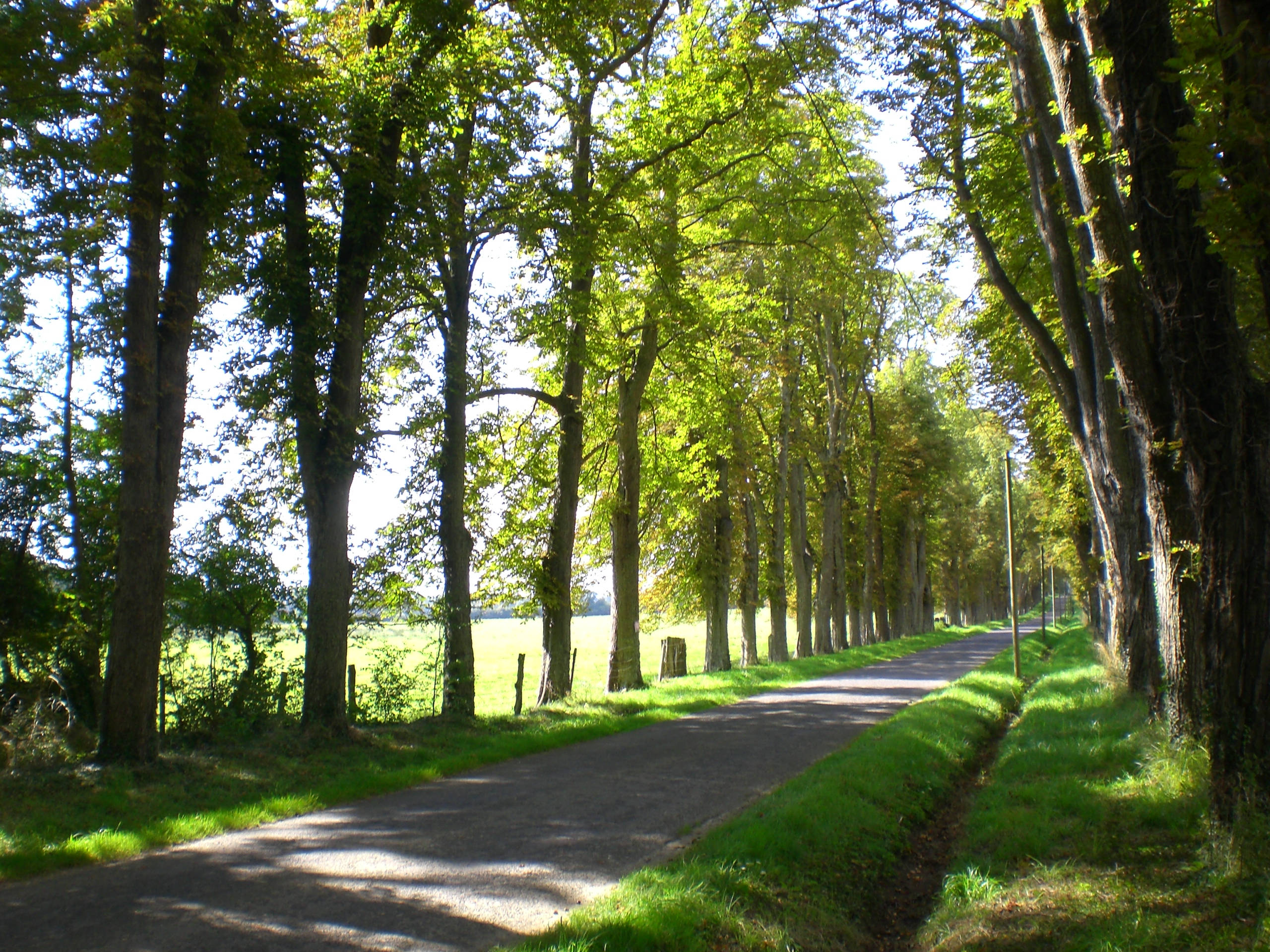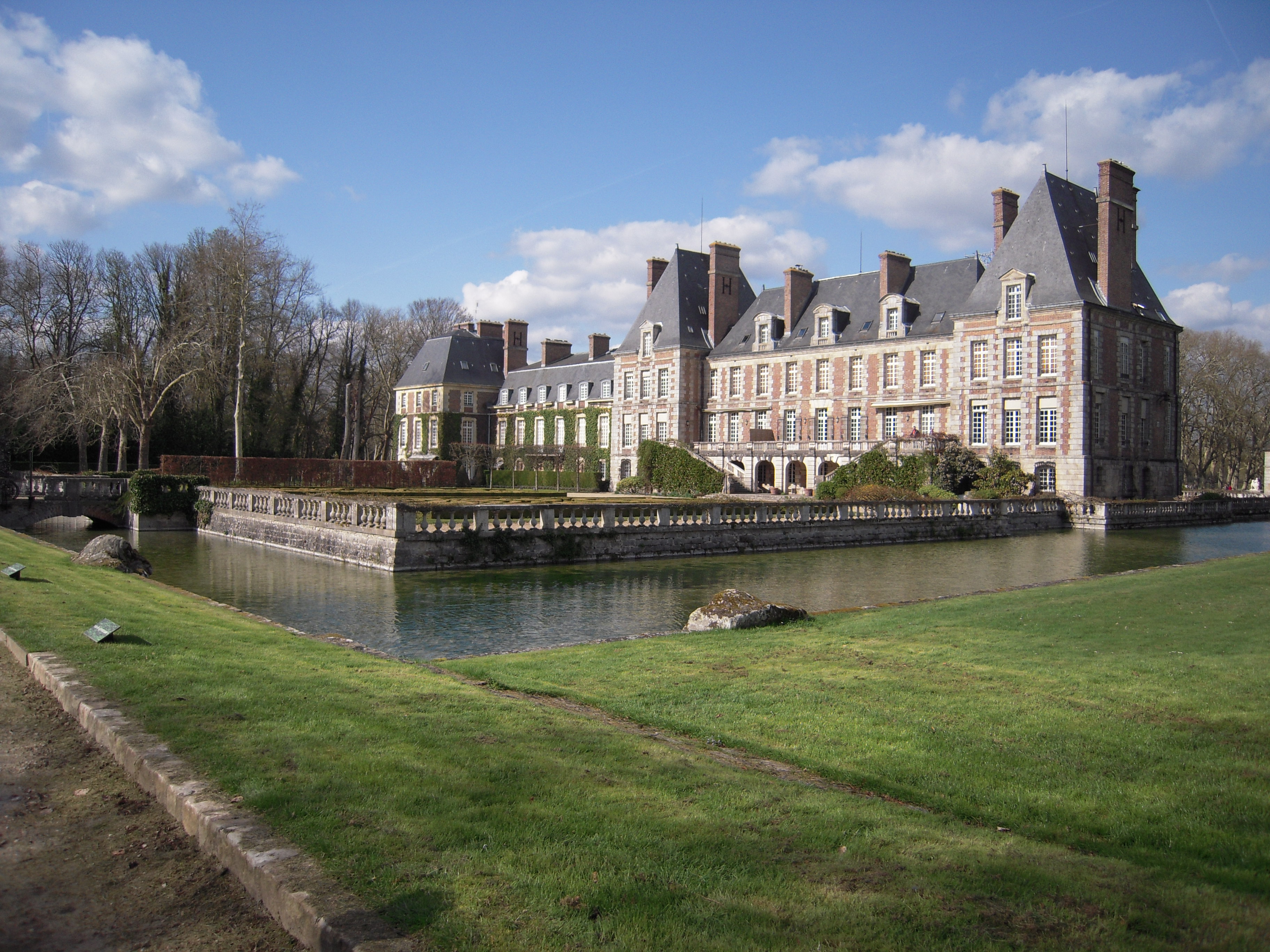|
Château De Courances
The Château de Courances () at Courances, Essonne is a French château built in approximately 1630. The house and gardens are open to the public. House In 1552, Côme Clausse, a notary and royal secretary to the King, acquired from the Lapite family the former seigneurial dwelling at Courances, at the western edge of the Forest of Fontainebleau. His heir conveyed it in 1622 to Claude Gallard, another royal secretary, who is doubtless the builder of the present château, of an H-plan laid out on a rectangular platform that is surrounded by a moat. The original Louis XIII style château is known from the engravings of Israël Henriet and Israël Silvestre, about 1650. The evaluation of the property drawn up in 1638 mentions, apart from the manor house, four barns, a press house, two wheat mills, and two mills "straddling the river". "Above and beyond this is a mill called the fulling mill, with the forecourt of said chateau on one side, and the stream of the pond on the other", ... [...More Info...] [...Related Items...] OR: [Wikipedia] [Google] [Baidu] |
Baron
Baron is a rank of nobility or title of honour, often hereditary, in various European countries, either current or historical. The female equivalent is baroness. Typically, the title denotes an aristocrat who ranks higher than a lord or knight, but lower than a viscount or count. Often, barons hold their fief – their lands and income – directly from the monarch. Barons are less often the vassals of other nobles. In many kingdoms, they were entitled to wear a smaller form of a crown called a ''coronet''. The term originates from the Latin term , via Old French. The use of the title ''baron'' came to England via the Norman Conquest of 1066, then the Normans brought the title to Scotland and Italy. It later spread to Scandinavia and Slavic lands. Etymology The word '' baron'' comes from the Old French , from a Late Latin "man; servant, soldier, mercenary" (so used in Salic law; Alemannic law has in the same sense). The scholar Isidore of Seville in the 7th century t ... [...More Info...] [...Related Items...] OR: [Wikipedia] [Google] [Baidu] |
Achille Duchêne
Achille Duchêne (1866 — 1947) was a French garden designer who worked in the grand manner established by André Le Nôtre. The son of the landscaper Henri Duchêne, Achille Duchêne was the garden designer most in demand among high French society at the turn of the twentieth century. He built up a large office to handle the practice, which was responsible over a period of years for some six thousand gardens in France and worldwide. Among the more notable commissions: * Château de Vaux-le-Vicomte for Alfred Sommier * Carolands, for Harriett Pullman Carolan in Hillsborough, California, USA * Château de Champs, Champs-sur-Marne, for Comte Louis Cahen d'Anvers * Château de Courances, for the marquise Jean de Ganay * Château du Marais, for comte Boni de Castellane (1903-1906) * Château de Breteuil (Yvelines) (with his father Henri Duchêne) * Château de Rosny-sur-Seine (Yvelines), for Paul Lebaudy (end of the nineteenth century) * Château de Voisins at Saint-Hilarion (Y ... [...More Info...] [...Related Items...] OR: [Wikipedia] [Google] [Baidu] |
Allée
In landscaping, an avenue (from the French), alameda (from the Portuguese and Spanish), or allée (from the French), is traditionally a straight path or road with a line of trees or large shrubs running along each side, which is used, as its Latin source ''venire'' ("to come") indicates, to emphasize the "coming to," or ''arrival'' at a landscape or architectural feature. In most cases, the trees planted in an avenue will be all of the same species or cultivar, so as to give uniform appearance along the full length of the avenue. The French term ''allée'' is used for avenues planted in parks and landscape gardens, as well as boulevards such as the ''Grande Allée'' in Quebec City, Canada, and ''Karl-Marx-Allee'' in Berlin. History The avenue is one of the oldest ideas in the history of gardens. An Avenue of Sphinxes still leads to the tomb of the pharaoh Hatshepsut. Avenues similarly defined by guardian stone lions lead to the Ming tombs in China. British archaeologists have ... [...More Info...] [...Related Items...] OR: [Wikipedia] [Google] [Baidu] |
Plane Tree
''Platanus'' is a genus consisting of a small number of tree species native to the Northern Hemisphere. They are the sole living members of the family Platanaceae. All mature members of ''Platanus'' are tall, reaching in height. All except for '' P. kerrii'' are deciduous, and most are found in riparian or other wetland habitats in the wild, though proving drought-tolerant in cultivation. The hybrid London plane (''Platanus ''×'' acerifolia'') has proved particularly tolerant of urban conditions, and has been widely planted in London and elsewhere in the United Kingdom. They are often known in English as ''planes'' or ''plane trees''. A formerly used name that is now rare is ''plantain tree'' (not to be confused with other, unrelated, species with the name). Some North American species are called ''sycamores'' (especially ''Platanus occidentalis''), although the term is also used for several unrelated species of trees. The genus name ''Platanus'' comes from Ancient Greek ... [...More Info...] [...Related Items...] OR: [Wikipedia] [Google] [Baidu] |
Jacques Dulaure
Ancient and noble French family names, Jacques, Jacq, or James are believed to originate from the Middle Ages in the historic northwest Brittany region in France, and have since spread around the world over the centuries. To date, there are over one hundred identified noble families related to the surname by the Nobility & Gentry of Great Britain & Ireland. Origins The origin of this surname ultimately originates from the Latin, Jacobus which belongs to an unknown progenitor. Jacobus comes from the Hebrew name, Yaakov, which translates as "one who follows" or "to follow after". Ancient history A French knight returning from the Crusades in the Holy Lands probably adopted the surname from "Saint Jacques" (or "James the Greater"). James the Greater was one of Jesus' Twelve Apostles, and is believed to be the first martyred apostle. Being endowed with this surname was an honor at the time and it is likely that the Church allowed it because of acts during the Crusades. Indeed, ... [...More Info...] [...Related Items...] OR: [Wikipedia] [Google] [Baidu] |
André Le Nôtre
André Le Nôtre (; 12 March 1613 – 15 September 1700), originally rendered as André Le Nostre, was a French landscape architect and the principal gardener of King Louis XIV of France. He was the landscape architect who designed the gardens of the Palace of Versailles; his work represents the height of the French formal garden style, or ''jardin à la française''. Prior to working on Versailles, Le Nôtre collaborated with Louis Le Vau and Charles Le Brun on the park at Vaux-le-Vicomte. His other works include the design of gardens and parks at Chantilly, Fontainebleau, Saint-Cloud and Saint-Germain. His contribution to planning was also significant: at the Tuileries he extended the westward vista, which later became the avenue of the Champs-Élysées and comprise the ''Axe historique''. Biography Early life André Le Nôtre was born in Paris, into a family of gardeners. Pierre Le Nôtre, who was in charge of the gardens of the Palais des Tuileries in 1572, may have ... [...More Info...] [...Related Items...] OR: [Wikipedia] [Google] [Baidu] |
French Formal Garden
The French formal garden, also called the (), is a style of garden based on symmetry and the principle of imposing order on nature. Its epitome is generally considered to be the Gardens of Versailles designed during the 17th century by the landscape architect André Le Nôtre for Louis XIV and widely copied by other European courts. Éric Mension-Rigau, "Les jardins témoins de leur temps" in '' Historia'', n° 7/8 (2000). History Renaissance influence The ''jardin à la française'' evolved from the French Renaissance garden, a style which was inspired by the Italian Renaissance garden at the beginning of the 16th century. The Italian Renaissance garden, typified by the Boboli Gardens in Florence and the Villa Medici in Fiesole, was characterized by planting beds, or parterres, created in geometric shapes, and laid out symmetrical patterns; the use of fountains and cascades to animate the garden; stairways and ramps to unite different levels of the garden; grottos, ... [...More Info...] [...Related Items...] OR: [Wikipedia] [Google] [Baidu] |
Courances Chateau Cote Jardin 01
Courances () is a commune in the Essonne department in Île-de-France in northern France. Inhabitants of Courances are known as ''Courançois''. See also *Château de Courances *Communes of the Essonne department The following is a list of the 194 communes of the Essonne department of France. The communes cooperate in the following intercommunalities (as of 2020): External links *Mayors of Essonne Association [...More Info...] [...Related Items...] OR: [Wikipedia] [Google] [Baidu] |
Western Union (alliance)
The Western Union (WU), also referred to as the Brussels Treaty Organisation (BTO), was the European military alliance established between France, the United Kingdom (UK) and the three Benelux countries in September 1948 in order to implement the Treaty of Brussels signed in March the same year.Although the Treaty goes no further than providing for 'cooperation' between the contracting parties, 'which will be effected through the Consultative Council referred to in Article VII as well as through other bodies', in practice the arrangement was referred to as ''Western Union'' or the ''Brussels Treaty Organisation''. Under this treaty the signatories, referred to as the ''five powers'', agreed to collaborate in the defence field as well as in the political, economic and cultural fields. During the Korean War (1950–1953), the headquarters, personnel and plans of the WU's defence arm, the Western Union Defence Organisation (WUDO), were transferred to the newly established North Atl ... [...More Info...] [...Related Items...] OR: [Wikipedia] [Google] [Baidu] |
Field Marshal Montgomery
Field Marshal Bernard Law Montgomery, 1st Viscount Montgomery of Alamein, (; 17 November 1887 – 24 March 1976), nicknamed "Monty", was a senior British Army officer who served in the First World War, the Irish War of Independence and the Second World War. Montgomery first saw action in the First World War as a junior officer of the Royal Warwickshire Regiment. At Méteren, near the Belgian border at Bailleul, he was shot through the right lung by a sniper, during the First Battle of Ypres. On returning to the Western Front as a general staff officer, he took part in the Battle of Arras in AprilMay 1917. He also took part in the Battle of Passchendaele in late 1917 before finishing the war as chief of staff of the 47th (2nd London) Division. In the inter-war years he commanded the 17th (Service) Battalion, Royal Fusiliers and, later, the 1st Battalion, Royal Warwickshire Regiment before becoming commander of the 9th Infantry Brigade and then General officer comma ... [...More Info...] [...Related Items...] OR: [Wikipedia] [Google] [Baidu] |
Nazi Germany
Nazi Germany (lit. "National Socialist State"), ' (lit. "Nazi State") for short; also ' (lit. "National Socialist Germany") (officially known as the German Reich from 1933 until 1943, and the Greater German Reich from 1943 to 1945) was the German state between 1933 and 1945, when Adolf Hitler and the Nazi Party controlled the country, transforming it into a dictatorship. Under Hitler's rule, Germany quickly became a totalitarian state where nearly all aspects of life were controlled by the government. The Third Reich, meaning "Third Realm" or "Third Empire", alluded to the Nazi claim that Nazi Germany was the successor to the earlier Holy Roman Empire (800–1806) and German Empire (1871–1918). The Third Reich, which Hitler and the Nazis referred to as the Thousand-Year Reich, ended in May 1945 after just 12 years when the Allies defeated Germany, ending World War II in Europe. On 30 January 1933, Hitler was appointed chancellor of Germany, the head of gove ... [...More Info...] [...Related Items...] OR: [Wikipedia] [Google] [Baidu] |







